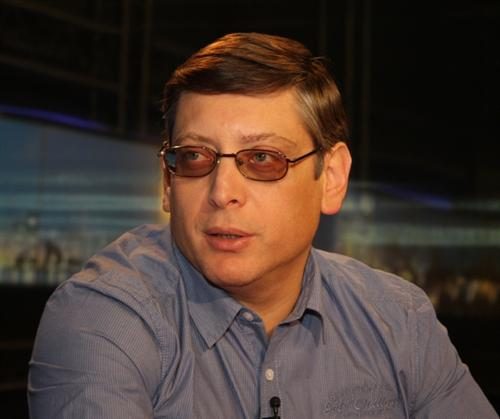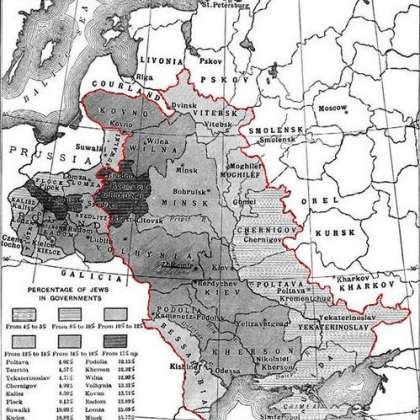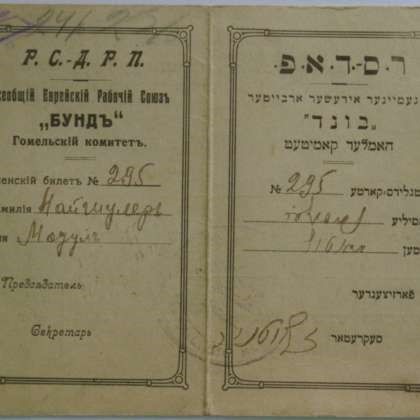The Jews of the Dnipro Region in an Era of Change

The historian Ihor Shchupak, who heads the Tkuma Ukrainian Institute for Holocaust Studies, talks about the politicization of the Jewish movement, coexistence between Jews and Ukrainians, and national minorities in the policies of the Ukrainian National Republic.
Andrii Kobaliya: What kinds of occupations did Jews pursue in Russian-ruled Ukraine during the second half of the nineteenth century?
Ihor Shchupak: Jews lived everywhere in the Russian Empire. The largest number lived in the Pale of Settlement, which included the territory of today’s Dnipropetrovsk region, then known as the Katerynoslav region. What occupations did they pursue? The ones in which they had always engaged. This was, first and foremost, the crafts, trade, and tax farming. A fascinating campaign aimed at attaching the Jews to the land began in the nineteenth century, during the reign of Nicholas І (1825–1855). It was thought that this would also change the nature of the Jewish community which would then become more integrated into Russian society. There was also a campaign aimed at turning Jews into soldiers. Usually after someone has served 25 years [in the army], it is harder to return to the community. That is, this was an assimilationist policy.
On the other hand, this campaign had both positive and negative consequences. At the time, Ukraine had become the largest Jewish farming region in the world. These colonies were situated in the southern part of today’s Ukraine. At the turn of the nineteenth century there were nearly 95 agricultural colonies. As regards other occupations, Jewish entrepreneurs in southern and eastern Ukraine were owners of 90% of all mills, 96% of the distilleries, and 80% of the breweries. Riverine transportation was also very important. Over 70% of all transportation on the Dnipro River was carried out by steamboats owned by the businessman Margolin. There was a sugar magnate named Brodsky.
There is a myth that Jews are always wealthy and own capital. Why? Perhaps because when a Ukrainian or a Russian possesses such wealth, it is unremarkable. He is among his own people. But Jews are very different, so when one of them is well off, this [perception—Trans.] extends to all Jews. In the late nineteenth century more than 20% of the Jews living in the Pale of Settlement were beggars. They were so poor that they could not survive without assistance from the Jewish community. You know about the long-standing tradition of Jewish charity requiring Jews to give one-tenth of their income to spiritual matters. More than 20% of Jews were supported by these funds.
Andrii Kobaliya: Ihor Shchupak went on to discuss Ukrainian-Jewish relations. Apart from conflicts and catastrophes, there were also periods of mutual understanding. One interesting detail of the anti-Jewish pogroms is the existence of Jewish self-defense.

Ihor Shchupak: With regard to relations between Ukrainians and Russians, on one side, and Jews, on the other, it is worthwhile noting that critical moments remain in our memory, because all the details of peaceful life are not retained in memory. If there was a pogrom or an uprising, of course, this is engraved in memory. That’s why it may seem sometimes that the history of the Jews in Ukraine is the history of continuous pogroms, although in reality this was absolutely not the case. Most of the time Jews coexisted normally with Ukrainians and other ethnicities. Jews were interested in adequate relations with Ukrainians, and not just during holidays, when Jews would look after cattle owned by Ukrainians at Eastertime; on Shabbat, Ukrainians tended cattle owned by Jews. Some ethnographers even collected proverbs on the theme of “When there’s trouble, go see a Jew.”
It was not always this good. There were pogroms. These pogroms escalated in the late nineteenth century. This was connected, first of all, with the politicization of social life; second, with the growth of the revolutionary movement, particularly of the Narodnaya Volya. Jews were also members of Narodnaya Volya, but its ideology and politics were often antisemitic. In the 1880s pogroms also took place in the Katerynoslav region. In 1883 all the agricultural colonies were wiped out. Why? When the tsarist government was implementing its land colonization policy, it tried to create minimal conditions, and allocate a certain amount of land. The local population thought this way: How can this be? Newcomers are granted such conditions, but we ourselves are living in poverty. This attitude was aimed not just at Jews.
In order to distract the population from more serious problems, the government sought to turn the people’s wrath against the Jews. The terrible pogrom of 1883 destroyed much Jewish property in Novomoskovsk and Katerynoslav. To a large extent, the pogrom of 1883 was spearheaded by a government bureaucrat. In the 1880s pogroms swept through 150 cities and towns in Russian-ruled Ukraine. In some cities, attackers encountered resistance from self-defense forces. The most effective one was in Odesa, where the pogroms were stopped and resistance was mounted. The same in Berdychiv. But Jews there formed the majority of the population. Later all this was supposedly investigated by commissions which decided that the people responsible for the pogroms were the Jews.

Andrii Kobaliya: In broaching the topic of the politicization of national movements, we moved from the conflictual pages in Ukrainian-Jewish history to the formation of the first Jewish political parties.
Ihor Shchupak: Jewish political parties began to be formed in the late nineteenth century. Branches of Hovevei Tsiyon, which means “Lovers of Zion,” appeared in Kharkiv, Odesa, and Kremenchuk.
Andrii Kobaliya: Please explain to our listeners what Zionism is.
Ihor Shchupak: If we explain this term through nationalism, then we’ll begin by talking about what nationalism is. Recently there was an interesting conference in Lviv, where Professor [Oleksandr] Zaitsev spoke about Ukrainian nationalism. One complex concept should not be explained by another. I would say that it is a Jewish national movement aimed at creating and consolidating a Jewish state in its historical fatherland, the Land of Israel. It is not aimed against someone, but it promotes the idea of gathering Jews in their historical fatherland. The founder of Zionism was Theodor Herzl, who organized the first Zionist congress in Basel in 1897. At the time he wrote in his diary something along the lines of “Today I created the Jewish state.” You may laugh, but fifty years later this became a fact. The UN adopted a resolution about the creation of the State of Israel.
Andrii Kobaliya: What spectrum of parties are we talking about?
Ihor Shchupak: Zionist organizations appeared in the majority of cities, including Katerynoslav. Our museum has documents devoted to this period. There are papers on which [the words] “If you are a Zionist” are written [in Russian]; you had to write your first name, surname, and profession. It is interesting that people often wrote on these papers in various languages: their name and surname in Yiddish, and their profession in Ukrainian or Russian. There were also branches of Poalei Tziyon [“Workers of Zion”], which sought to link the idea of Zionism with socialist ideas. The Bund, which was also founded in 1897, gained great popularity. For some time it was part of the RSDRP [Russian Social Democratic Labor Party], until 1903, when a split [in the ranks of the RSDRP] took place at the Second Congress. Some radicals went with Lenin. That’s how the Bolsheviks emerged. But the minority—the Mensheviks—proposed moderate actions. The Bund belonged to the minority. Jews took part in all-Russian and Ukrainian parties. Edelman was one of the leaders of the Union of Struggle for the Liberation of the Working Class.
The political struggle continued to intensify. Members of the Black Hundreds and reactionary, right-wing organizations championed the idea of a “single, undivided Russia,” advocated monarchy, and demonstrated a clear-cut antisemitic character. Among them were the Union of the Russian People and the Union of the Archangel Michael. The Grand Prince was a member of one of these organizations, Nicholas II supported it.
As regards the events of 1905, here we must also recall the Kishinev pogrom of 1903, after which a wave of Jews flooded into the USA and Canada. The beginning of the first Russian Revolution was followed by pogroms. In some cities they were foiled, like the one in Melitopol. In the spring of 1905 horrible events took place in Odesa, Kyiv, Yuzivka, Kremenchuk, and Katerynoslav. The Beilis affair can be mentioned here, too.
Andrii Kobaliya: At the end of our conversation Ihor Shchupak mentioned the events of the Ukrainian Revolution and the question of national minorities during this period.
Ihor Shchupak: The Ukrainian Revolution was very sympathetic to all national minorities. The Ukrainian Central Rada acted as a representative of the interests of all Ukrainians. The Small Rada was composed of 16 representatives of Jewish parties and organizations; 36 Ukrainian, 9 Russian, and 4 Polish. The Large Rada had two hundred seats, fifty of which were granted to Jews; one-quarter. In November 1917 there was an entire body that dealt with Jewish affairs. When the Ukrainian Central Rada was created, the yellow-and-blue [Ukrainian] flag, the white-blue-red flag in honor of the Russian community, the white-and-red Polish, and the Jewish flag were raised. If credence is given to recollections of this, it was the first time that the Jewish flag, as a symbol, was raised at any state institution in two thousand years.
Further events involving resistance and pogroms created a very negative image of Ukraine in the world. Eventually Timothy Snyder would call it the “bloodlands.” These were truly bloodlands. The pogroms were carried out by Denikin’s White forces and bandits from irregular army formations that recognized the Ukrainian Central Rada, the Directory, or Petlyura. Such pogroms were called “Petlyurite,” which is an incorrect term, in my opinion. Pogroms were also carried out by the Reds, including subunits commanded by Shchors, Kotovsky, and Budenny’s army.
The program was created with the support of the non-profit organization Ukrainian Jewish Encounter.
Listen to the podcast in Ukrainian on Hromadske Radio here.



















